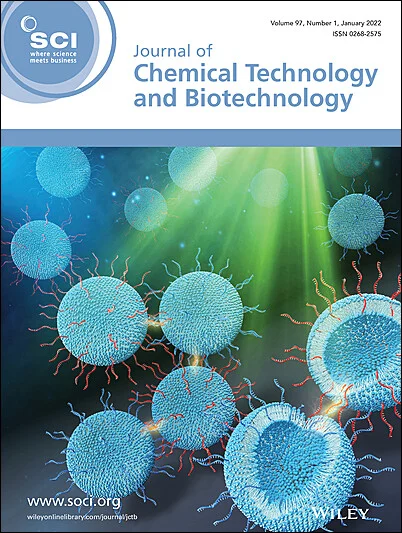Tamara Janković, Adrie J. J. Straathof, Siddhant Sharma, Anton A. Kiss
下载PDF
{"title":"Eco-efficient recovery of non-volatile products from fermentation broth: aliphatic diols","authors":"Tamara Janković, Adrie J. J. Straathof, Siddhant Sharma, Anton A. Kiss","doi":"10.1002/jctb.70040","DOIUrl":null,"url":null,"abstract":"<p>Fermentation can be used to obtain a wide variety of valuable high-boiling components. Among these components, microorganisms can produce aliphatic diols (e.g. propanediols, butanediols, etc.) in significant concentrations (e.g. 5–15 wt.%). Nonetheless, the high boiling points of these components, presence of microorganisms, and formation of by-products complicate recovery after fermentation. Hence, this perspective offers valuable insights into downstream processing options. A novel methodology was developed for recovering high-boiling components from dilute aqueous solutions, whereby both light and heavy impurities are present. The main steps in the proposed methodology are heat pump-assisted preconcentration and final purification in a dividing-wall column. These steps allow effective separation of high-purity product from water, light and heavy impurities. Furthermore, processes for recovery of 1,3-propanediol, 2,3-, 1,4- and 1,3-butanediol, designed according to the proposed methodology, were compared. Downstream processing performance is mainly determined by the product concentration in the fermentation broth, but is also influenced by the amount of impurities in the broth. © 2025 The Author(s). <i>Journal of Chemical Technology and Biotechnology</i> published by John Wiley & Sons Ltd on behalf of Society of Chemical Industry (SCI).</p>","PeriodicalId":15335,"journal":{"name":"Journal of chemical technology and biotechnology","volume":"100 11","pages":"2245-2250"},"PeriodicalIF":2.4000,"publicationDate":"2025-08-12","publicationTypes":"Journal Article","fieldsOfStudy":null,"isOpenAccess":false,"openAccessPdf":"https://scijournals.onlinelibrary.wiley.com/doi/epdf/10.1002/jctb.70040","citationCount":"0","resultStr":null,"platform":"Semanticscholar","paperid":null,"PeriodicalName":"Journal of chemical technology and biotechnology","FirstCategoryId":"5","ListUrlMain":"https://scijournals.onlinelibrary.wiley.com/doi/10.1002/jctb.70040","RegionNum":4,"RegionCategory":"生物学","ArticlePicture":[],"TitleCN":null,"AbstractTextCN":null,"PMCID":null,"EPubDate":"","PubModel":"","JCR":"Q3","JCRName":"BIOTECHNOLOGY & APPLIED MICROBIOLOGY","Score":null,"Total":0}
引用次数: 0
引用
批量引用
Abstract
Fermentation can be used to obtain a wide variety of valuable high-boiling components. Among these components, microorganisms can produce aliphatic diols (e.g. propanediols, butanediols, etc.) in significant concentrations (e.g. 5–15 wt.%). Nonetheless, the high boiling points of these components, presence of microorganisms, and formation of by-products complicate recovery after fermentation. Hence, this perspective offers valuable insights into downstream processing options. A novel methodology was developed for recovering high-boiling components from dilute aqueous solutions, whereby both light and heavy impurities are present. The main steps in the proposed methodology are heat pump-assisted preconcentration and final purification in a dividing-wall column. These steps allow effective separation of high-purity product from water, light and heavy impurities. Furthermore, processes for recovery of 1,3-propanediol, 2,3-, 1,4- and 1,3-butanediol, designed according to the proposed methodology, were compared. Downstream processing performance is mainly determined by the product concentration in the fermentation broth, but is also influenced by the amount of impurities in the broth. © 2025 The Author(s). Journal of Chemical Technology and Biotechnology published by John Wiley & Sons Ltd on behalf of Society of Chemical Industry (SCI).
从发酵液中高效回收非挥发性产物:脂肪族二醇
发酵可用于获得各种有价值的高沸点成分。在这些成分中,微生物可以产生显著浓度(例如5 - 15wt .%)的脂肪族二醇(例如丙二醇、丁二醇等)。然而,这些成分的高沸点、微生物的存在和副产品的形成使发酵后的恢复变得复杂。因此,这个视角为下游处理选项提供了有价值的见解。开发了一种新的方法,用于从稀水溶液中回收高沸点组分,其中存在轻杂质和重杂质。所提出的方法的主要步骤是热泵辅助的预浓缩和在分隔墙柱中的最终净化。这些步骤可以有效地将高纯度产品与水、轻杂质和重杂质分离。此外,比较了根据所提方法设计的1,3-丙二醇、2,3-、1,4-和1,3-丁二醇的回收工艺。下游加工性能主要由发酵液中的产物浓度决定,但也受发酵液中杂质含量的影响。©2025作者。由John Wiley &; Sons Ltd代表美国化学工业学会(SCI)出版的化学技术与生物技术杂志。
本文章由计算机程序翻译,如有差异,请以英文原文为准。


 求助内容:
求助内容: 应助结果提醒方式:
应助结果提醒方式:


